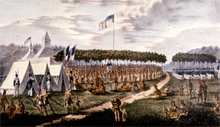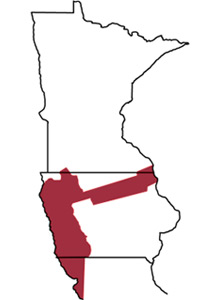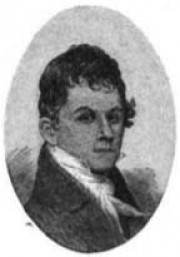Multinational Treaties at Prairie Du Chien
Sioux, etc. signed August 19, 1825
Sauk & Foxes signed July 15, 1830
In 1825, Dakota and Ojibwe leaders from what is now Minnesota joined members of nearly a dozen other nations for a peace treaty in Prairie du Chien, WI. The U.S. was ostensibly concerned with violence among the American Indian nations on its western border, and insisted that living within set boundaries for the first time in history would solve the problem. American Indian delegation members pointed out that the game they hunted for their livelihoods did not recognize boundaries, and the arrangement would cause more problems than it solved. The treaty was a compromise: boundaries were set, but articles of the treaty acknowledged that American Indians would ignore the boundaries.
In this treaty, American Indian nations were negotiating their positions relative to one another as much as to the U.S., and vying for access to trade goods. William Clark and Lewis Cass, negotiators for the U.S., declared that their country had no designs on land northwest of the Mississippi, and never would. Subsequent treaties (such as an 1826 Ojibwe treaty) were planned to reach nations and bands who had an interest in the vast territory under discussion but were absent at Prairie du Chien.
One affect of the treaty, however, was to “clear the title” to the lands of American Indians, making it easier to purchase specific tracts from single American Indian nations. Within 3 years, the U.S. was purchasing land within the boundaries set in 1825.
As predicted, lines on a map did not end historical tensions among American Indians west of the Mississippi. In fact, these tensions would rise as the eastern tribes were moved across the river. In 1830, William Clark engineered another treaty at Prairie du Chien with selected leaders of the Sac and Fox, plus leaders of the Dakota, Omaha, Iowa, Oto and Missouri. After threatening a military invasion and trade embargo, the U.S. insisted that peace among American Indians would require land cessions by the Dakota and Sac and Fox. One large tract of this land would remain open to the Sac and Fox for hunting and other purposes, but would also be opened to settlement by other American Indian nations. A smaller strip would become a “neutral ground,” and Ho- Chunk people would be relocated there as a buffer between the Dakota and the Sac and Fox.

















